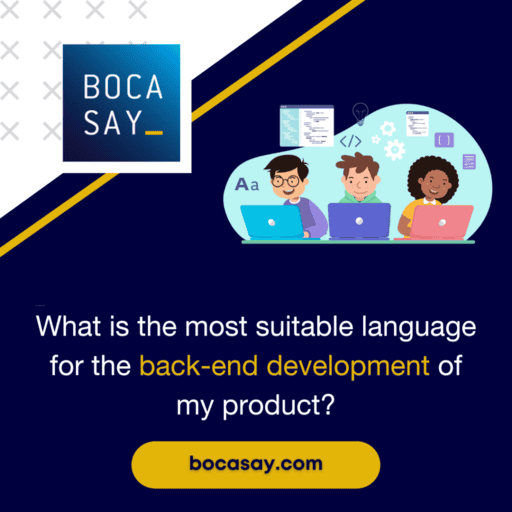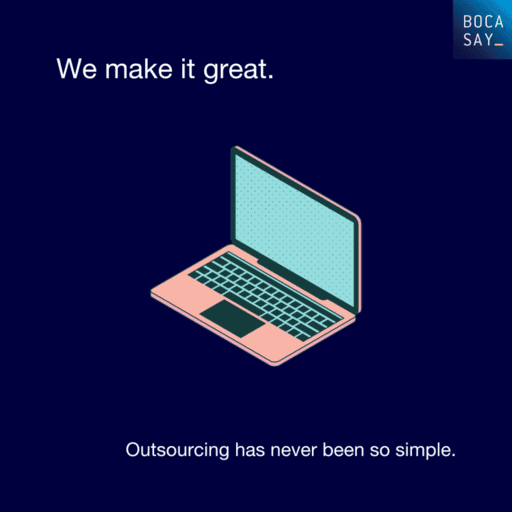Top Frameworks for Back-End Web Development
Back-end development refers to how a website functions, updates and changes. Upon the long journey of developing a web application, choosing the most appropriate back-end technology that will ultimately drive the application, is the first and most important step.
As a developer, you will often have to work within a framework that you are already familiar with. However, while staying in your comfort zone is obviously easier, it is now always the best option for your project.
It is therefore important to choose the right technology stack (combination of tools, applications and services used to create a web application) before starting a new project.
In this article, Bocasay, an offshore web agency, provides an overview of the most used back-end frameworks for web development, as well as their key characteristics to consider for your next project.

What is back-end development?
The back-end is essentially the engine of your IT solution, composed of various parts related to databases, servers and applications. It is widely considered the ‘root’ interface of a particular software.
Within web development, the back-end environment is one of the most crucial aspects and it is developed with various programming languages.
Here is a short summary of what back-end development involves:
- Contains the code that runs on the server side.
- Is responsible for handling and managing the storage.
- Manages the database and other resources.
As the back-end represents the data access layer of your software, it is absolutely necessary to choose your back-end development framework carefully.
It’s now time to discover the top back-end frameworks for web development.
Django
🧑💻 Programming language: Python / HTML
Django is a high-level framework that enables the rapid development of secure and easy-to-maintain websites.
Built by experienced developers, Django basically performs most of the tedious work of web development and allows you to focus on building your application.
It is a free, open-source framework with an active and vibrant community, excellent documentation, and a host of free and paid support options.
➕ Positives: Django’s computational and statistical capability is ideal for machine learning.
➖ Negatives: Django is not well-suited for small-scale projects.
Express.js
🧑💻 Programming language: JavaScript
Express.js is one of the best JavaScript frameworks currently used in back-end web development. Its primary use is to create APIs that accept requests from the front-end and subsequently send back appropriate responses.
In fact, Express.js is essentially a JavaScript library you can use in order to create a back-end that scales your application quickly. Easy to learn and widely supported by a global community of developers.
➕ Positives: Impressive flexibility.
➖ Negatives: Low security.
Flask
🧑💻 Programming language: Python
Flask is a framework that allows you to build a web application by providing tools, libraries and various other web technologies. This framework is classified as a micro-framework, which means that it relies very little, if at all, on external libraries.
➕ Positives: Offers easy scalability.
➖ Negatives: Not suitable for large-scale application development.
𝕐𝕠𝕦 𝕨𝕒𝕟𝕥 𝕥𝕠 𝕕𝕖𝕧𝕖𝕝𝕠𝕡 𝕒 𝕨𝕖𝕓 𝕒𝕡𝕡𝕝𝕚𝕔𝕒𝕥𝕚𝕠𝕟, 𝕓𝕦𝕥 𝕪𝕠𝕦 𝕕𝕠𝕟’𝕥 𝕜𝕟𝕠𝕨 𝕨𝕙𝕖𝕣𝕖 𝕥𝕠 𝕤𝕥𝕒𝕣𝕥? ℂ𝕙𝕠𝕠𝕤𝕖 𝕒 𝕡𝕣𝕠𝕘𝕣𝕒𝕞𝕞𝕚𝕟𝕘 𝕝𝕒𝕟𝕘𝕦𝕒𝕘𝕖, 𝕒 𝕗𝕣𝕠𝕟𝕥𝕖𝕟𝕕 𝕒𝕟𝕕 𝕓𝕒𝕔𝕜𝕖𝕟𝕕 𝕗𝕣𝕒𝕞𝕖𝕨𝕠𝕣𝕜, 𝕗𝕚𝕟𝕕 𝕥𝕙𝕖 𝕣𝕚𝕘𝕙𝕥 𝕕𝕖𝕧𝕖𝕝𝕠𝕡𝕖𝕣𝕤? 𝕋𝕙𝕖 𝕠𝕗𝕗𝕤𝕙𝕠𝕣𝕖 𝕨𝕖𝕓 𝕒𝕘𝕖𝕟𝕔𝕪 𝔹𝕠𝕔𝕒𝕤𝕒𝕪 𝕒𝕔𝕔𝕠𝕞𝕡𝕒𝕟𝕚𝕖𝕤 𝕪𝕠𝕦 𝕗𝕣𝕠𝕞 𝔸 𝕥𝕠 ℤ! ℂ𝕠𝕟𝕥𝕒𝕔𝕥 𝕦𝕤 𝕟𝕠𝕨 𝕗𝕠𝕣 𝕒 𝕗𝕣𝕖𝕖 𝕢𝕦𝕠𝕥𝕖!
Laravel
🧑💻 Programming language: PHP
As an open-source framework, Laravel is constantly being improved by developers who create new modules and features.
Laravel eliminates all vulnerabilities associated with handling complex PHP code. It has an expressive and elegant syntax which makes the entire web development process faster, easier and more enjoyable for developers to handle.
➕ Positives: Cost-effective.
➖ Negatives: Low security.
Ruby on Rails
🧑💻 Programming language: Ruby / JavaScript / HTML
Ruby on Rails is a popular web development technology. This open-source framework powers a multitude of websites, with some of the biggest tech-giants deploying this technology stack within their applications. Rails offers you a very robust, dynamic, and most importantly, faster development result.
➕ Positives: Fast development.
➖ Negatives: Lack of flexibility.

Spring
🧑💻 Programming language: Java
The Spring Framework provides a comprehensive programming and configuration model for modern, Java-based enterprise applications on any type of delivery platform.
Spring’s focus on “installation” of enterprise applications allows teams to focus on the business logic of the application layer, without being unnecessarily tied to a particular delivery environment.
➕ Positives: High security.
➖ Negatives: Complex-to-use.
ASP.NET Core
🧑💻 Programming language: C#
ASP.Net Core reduces the number of lines of code required in order to develop large and complex applications. It enables you to perfectly combine ASP code and HTML to generate dynamic web pages.
ASP.Net Core is an ideal server-side scripting technology. In fact, its code is executed on Windows servers before being displayed in a web browser.
➕ Positives: Compatible with many other platforms.
➖ Negatives: Complex-to-use.
CakePHP
🧑💻 Programming language: PHP
CakePHP is an open-source platform commonly used to develop PHP frameworks. It is an MVC (Model-View-Controller)-based model aimed at facilitating the distributed creation of web applications.
CakePHP’s extensive library support allows developers to clearly and easily adopt this view. The runtime infrastructure framework makes things possible with CakePHP. Lines of code are generally reduced.
➕ Positives: Fast development.
➖ Negatives: Does not support default routes for URLs.
Conclusion
As if choosing a framework isn’t difficult enough, always consider that each framework has its own strengths and weaknesses, that no single framework is better than all the others.
In some projects, different technologies can be used interchangeably. That’s why it’s so important to make informed decisions instead of relying on myths or always sticking to the simplest and cheapest solutions.
However, what is undeniable when choosing a back-end framework, is that speed, reliability and scalability are the most important criteria.
Before deciding which back-end solution is best for a particular project, consider your application’s use-cases and business needs. And, for even more details, you can just ask us directly 🙂